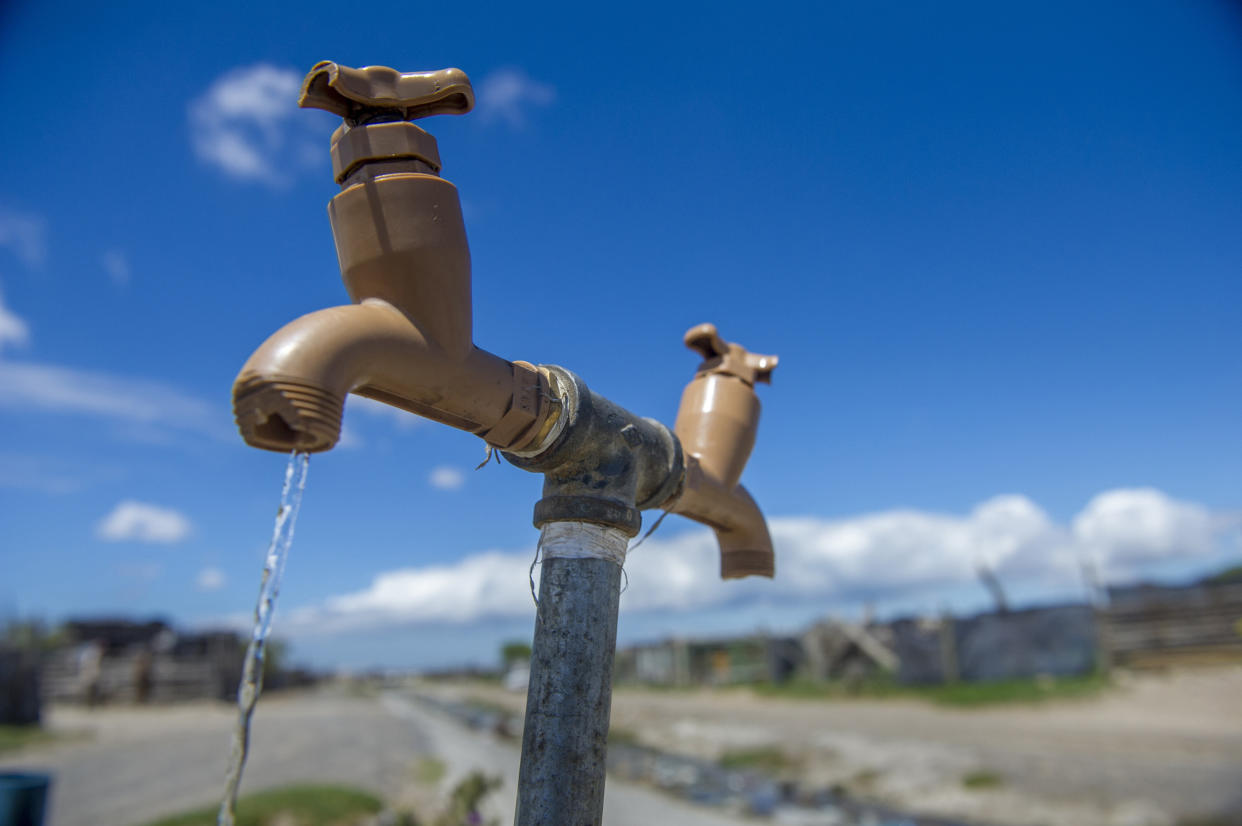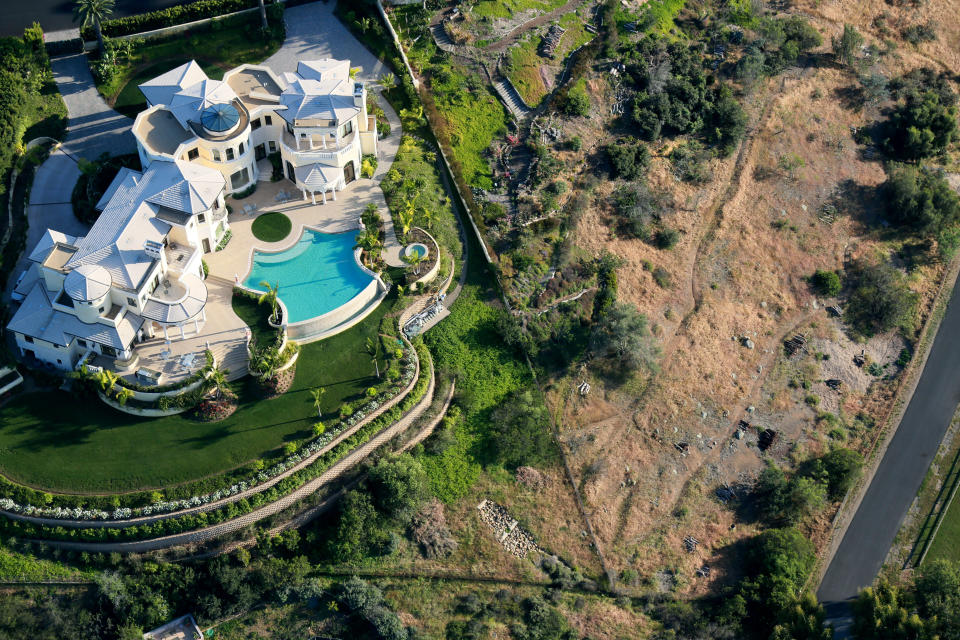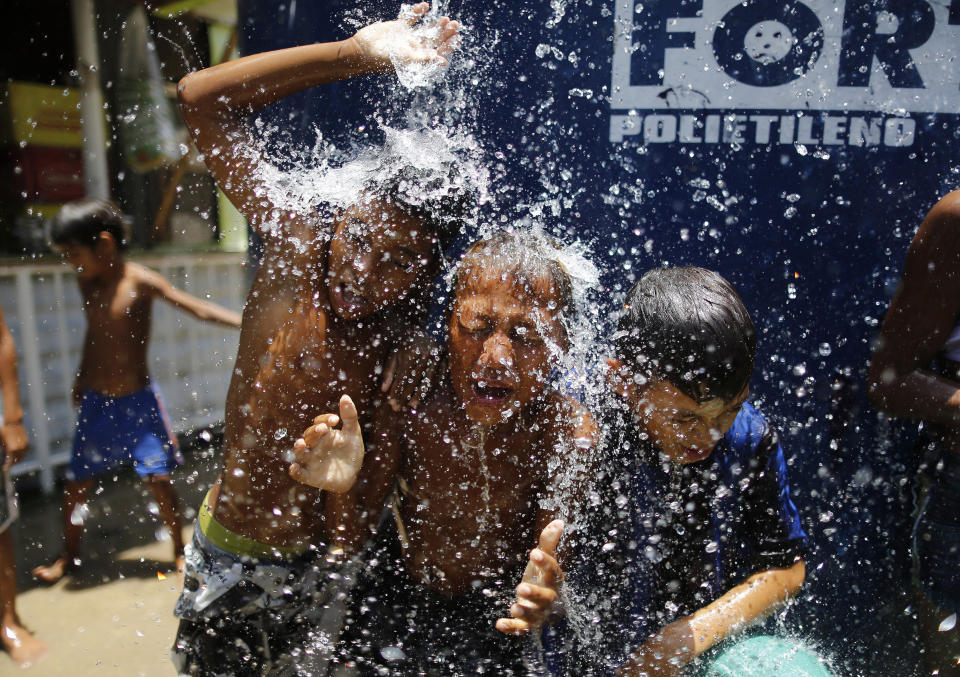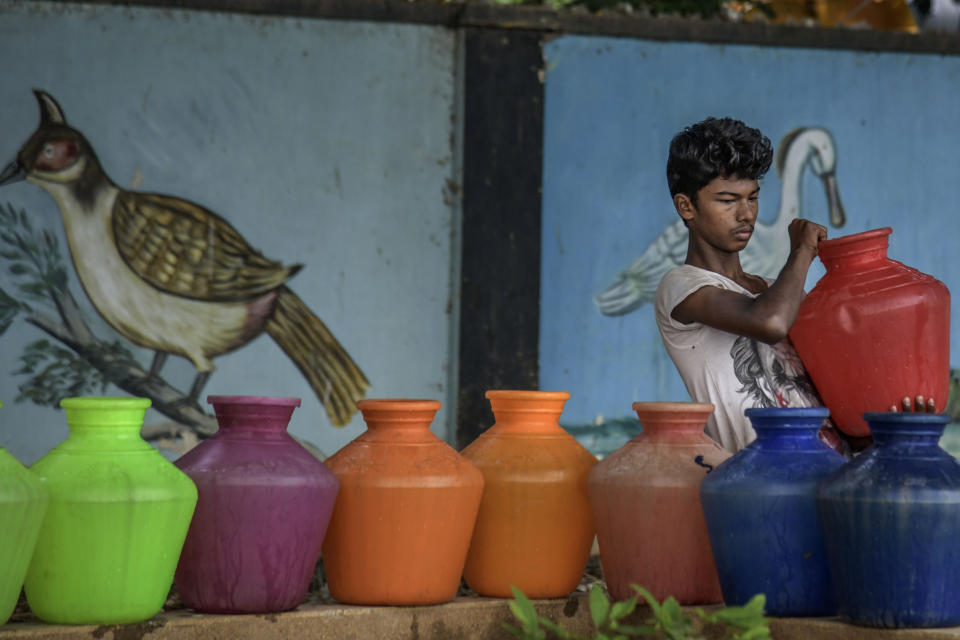The Water Crisis In Cities Everywhere Is Worsening Already Terrible Inequality

By the time Chennai’s water crisis made international headlines, and images of the Indian city’s desiccated reservoirs were being broadcast around the world, and officials acknowledged in late June that they had reached “Day Zero” and the pipes had run dry, Deepan’s family had been without a reliable water supply for months.
The tanker trunks that previously brought water to Deepan’s neighborhood every other day had started to come just once or twice a week. His community had worked together to sink a bore well a few years back, but they weren’t able to extract any usable water. Their neighborhood was built on top of a landfill. “This was ― and is ― a garbage area,” said Deepan, who goes by one name. “So the groundwater has this brownish tinge.”
His family started washing and bathing less. They’d take days off work, and lose wages, in order to collect drinking water by the bucketful from faraway filling stations.
“My brother and I, we’d collect water from a neighboring area,” said the 31-year-old event planner. “We went where the rich people live.” When the residents of that neighborhood complained about water problems, the government would always respond.
“Ours is a kind of slum area,” Deepan said. “For us, water is always an issue.”
Water isn’t just an issue in Chennai. In many parts of the world, extreme droughts, poor water management and increasing demand have made water crises almost commonplace.
In a report published this year, the World Resources Institute (WRI) found that 17 countries — home to a quarter of the global population — face “extremely high” levels of water stress. These countries ― which include India, Eritrea, Botswana and many Middle Eastern nations ― draw more than 80% of their available water supply each year, leaving them extraordinarily vulnerable to even short periods of drought. Elsewhere, some regions are running out of water even within countries that overall have low water stress, like South Africa, Brazil and the U.S.
Last year, Cape Town, South Africa, narrowly avoided its own Day Zero crisis. São Paulo had a scare as well, after barely recovering from a severe drought in 2014 when the city’s reservoirs dipped to just 3% of their capacity. And across California, farmland was left fallow and in some areas the land sunk two feet after several years of drought had drained groundwater.
As with many aspects of the climate crisis, the impacts of water shortages hit unequally. While wealthier people are able to buy private supplies, drill boreholes and in some cases carry on filling their swimming pools, poorer people, who already use less water and pay more for it, have few options. Globally, about 650 million people don’t have access to safe drinking water.
“Day Zero exists for a lot of people all year long,” said Betsy Otto, director of WRI’s Global Water Program.

The concept of Day Zero was first introduced last year by Cape Town as a way to startle citizens into action. After three years of drought, the city’s dams were drying up, and its four million residents needed to dramatically conserve the remaining supply.
Day Zero didn’t mean that Cape Town would actually be left with zero water. “It simply marked the day the dams would reach 13.5% capacity,” explained Gina Ziervogel, an environmental scientist at the University of Cape Town who studied the water crisis. At 13.5% capacity, there would be just barely enough water to keep critical services running. The taps in homes and businesses would be turned off. Residents would have to line up at one of 200 collection sites to obtain rations to drink and bathe. Chaos could break out, officials warned.
“It put that fear into people,” Ziervogel said.
The city published a weekly water report, tracking how much was left in the dams. Public service announcements blasted out water-saving techniques, and the mayor made house calls, urging excessive consumers to cut back.
And it worked — more or less. The government never had to shut off the taps.
But the crisis highlighted economic and racial disparities. “In an unequal country, things like the water crisis really throw into the spotlight just how bad the inequality is,” Ziervogel said.

In wealthy and predominantly white areas of the city, the “borehole bourgeoisie” dug up their own private supplies of water. Meanwhile, people living in the shacks of “informal settlements” had always collected daily water from communal taps. As the crisis loomed, they lined up through the night to collect water rations and worried about how they would manage with even less. The city government promised that the settlements would receive water as long as it was available, to prevent the spread of disease in those densely populated areas.
Capetonians living in informal settlements, who make up a quarter of the city’s population, use less than 5% of the city’s water supply. The Day Zero campaign in Cape Town was “really a way to drive change amongst those who used the most water,” Ziervogel said.
To avert Day Zero, the government pushed all residents to use no more than 13.2 gallons of water daily. People who watered lawns and washed cars were fined. “There were regulations for people to cover their pools to prevent evaporation,” Ziervogel said.
As a result, “people’s relationship with water changed,” she said. Even after the crisis passed, “for a lot of people those water-wise habits have remained.”
More than five thousand miles away, this kind of reassessment sounds right to Priya Mohan, who moved from San Francisco to Chennai in 2014. Her city’s Day Zero has forced her to grapple with the vulnerability of her own water supply. “I think this is making me and my kids a little more understanding,” she said. “It makes us think about our responsibility to our community.”
Mohan was surprised by the depth of the crisis in the Indian city. The month of May corresponds with a month in the Tamil calendar called Agni Nakshatram. “Agni, meaning fire,” she explained. “The hottest part of the year in Chennai is May — and by May this year we knew we were going to be in deep trouble.” And then, she said, “one fine day, there was absolutely no water.”
During the worst of the drought, the five households in Mohan’s building invited cleaners, home care providers and other staff without water at home to shower in the building. When the taps in Mohan’s building fizzled out of commission, the five households all chipped in to buy a truckload of water for between $50 and $100 every other day from a private supplier. Everyone made an effort to take fewer showers. Some collected water leaking out of their air conditioning units and used it to mop or water plants.
As the summer wore on, some schools shut down. But her kids weren’t really affected, Mohan said. “You know, I taught them, ‘If you’re brushing your teeth, fill up in a mug and only use that much.’ And I’d say no baths.” Overall, her family’s day-to-day life wasn’t disturbed too much.
“We are the lucky few because we can use some kind of influence and somehow we will manage,” Mohan said. “But as a city, we’re going to struggle. I’m very concerned for the people of Chennai.”
Love HuffPost? Become a founding member of HuffPost Plus today.

Though the poor are affected first and most, as slow-building water crises around the world reach tipping points, shortages are starting to affect the affluent as well. “It’s become an equal opportunity crisis in a way,” said WRI’s Otto. The silver lining is that people with means and power are “understanding how urgent the matter is,” she added.
Globally, water withdrawal has more than doubled since the 1960s — with households, agricultural operations and industries guzzling more water than ever before. That’s because the world’s population has been increasing. Incomes have been growing as well, leading to rising demand for water-intensive products like meat and fossil fuels. According to the United Nations, demand for water will increase by an additional 20% to 30% by 2050.
But as the world asks for more water, rainfall has become much less reliable. “With climate change, we’re seeing more uncertain and more erratic rainfall,” said Otto. Extended heat waves are evaporating reservoirs. A phenomenon called Hadley cell expansion is pushing clouds and rain from the equator toward the north and south poles, drying out sub-Saharan Africa, the Middle East and Central America.
Some regions are coping with both extreme droughts and extreme floods. In 2015, Deepan’s family home in Chennai was submerged and destroyed by flooding that killed hundreds. “There was no electricity supply in our area for about 10 days,” he said. “The water rose up to my neck level — I am six feet tall.”
As heavy monsoon rains douse the city at the close of 2019, Deepan said he’s nervous that the drainage system in his neighborhood will fail once again, flooding his home with wastewater. Ironically, a deluge could also lessen his access to usable drinking water — the trucks that bring water to his area can’t get there if the roads are closed.

While cities around the world are united in their vulnerability to water shortages, each water crisis is a bit different.
In many parts of the world, a dizzyingly complex web of water management bureaucracy is partly to blame. In Chennai, the officials who serve on water boards usually don’t have any particular expertise in ecology or civil engineering. Politicians who rotate in and out of top positions have little time to enact any lasting structural change. “They all propose these expensive, large mega-projects,” said Veena Srinivasan, a researcher with the Indian conservation group ATREE. They want to build new dams or costly desalination plants that convert seawater into clean drinking water.
But there’s not enough political incentive to do the “small, painful, annoying little things to manage water,” Srinivasan said. “I mean we don’t even have a way to track how much water is being used, where and by whom.”
Water management messes have also affected California, where a long-running battle between agriculture and everyone else plays out within government agencies and courts. The state has never faced a Day Zero-style crisis, but during the worst of the prolonged 2011-2015 drought, powerful farm lobbies competed with metropolitan agencies for access to the state’s dwindling reserves as environmental groups and fishing communities warned that overdrawing the water supply endangered Chinook salmon and Delta smelt. Meanwhile, toxic runoff from the Central Valley farms that soak up the majority of the state’s supply tainted the tap water of rural towns scattered through the region — and continues to do so.
In Rome, which two years ago lowered water pressure to conserve the resource amid a severe drought, the local water utility scrambled to repair thousands of kilometers of ancient water pipes to stop the loss of hundreds of liters per second.
São Paulo loses a third of its treated water to leaks and theft. Because Brazil relies so heavily on hydropower for electricity, experts worry that future droughts could decimate the country’s economy.
There’s no one easy solution to the world’s water woes, Otto said. In broad strokes, every city and country needs to figure out how to use water more efficiently.
Some of the most straightforward interventions can bring broad benefits for every part of society, Otto said. Capturing and treating wastewater can boost poor communities, which are particularly vulnerable to waterborne diseases, and make more water available for everyone. “Always, the quickest, cheapest, best source of more water is the water you don’t waste,” she said.
Restoring wetlands and natural watersheds can similarly help alleviate inequality. Mangroves can protect coastal communities from storm surges, Otto noted, and urban forests “can act as sponges, absorbing rainwater, filtering it and slowly releasing it back,” at once preventing flooding and replenishing groundwater reserves.
“I encourage people to just learn more about the issues in their communities,” she said. “How secure are our water supplies? Where is the water going? Do our water rates even cover the cost of maintaining the system? These are reasonable questions we should all be asking.”

In Chennai, the monsoon rains haven’t washed away Deepan’s worries over drought. He hopes this latest scare will motivate the government to make some changes — “Lots of improvements are needed,” he said ― but he hasn’t seen any evidence of action yet.
In Deepan’s neighborhood, even small upgrades have been hard-won. It took almost six years for the government to install the hand pumps it had promised the community. “Now the pumps are there,” he said. But in a few months, when summer comes around, “there will be no water in them.”
It’s unclear where or when, exactly, the next Day Zero crisis will hit. “But all around, what we can see is that there are underlying factors and problems that are flashing red,” Otto said. “We can’t just continue to bury our heads in the sand.”
If it matters to you, it matters to us. Support HuffPost’s journalism here. For more content and to be part of the “This New World” community, follow our Facebook page.
HuffPost’s “This New World” series is funded by Partners for a New Economy and the Kendeda Fund. All content is editorially independent, with no influence or input from the foundations. If you have an idea or tip for the editorial series, send an email to thisnewworld@huffpost.com.
Related Coverage
She Visited Every Country On Earth. She Saw A World Overwhelmed By Plastic Trash.
Climate Change Is Threatening Our Jobs — And Most Companies Are Doing Nothing
Politicians And CEOs Could Face Criminal Charges For Environmental Destruction
This article originally appeared on HuffPost.

